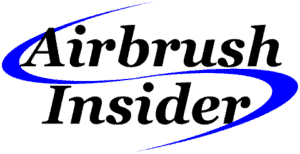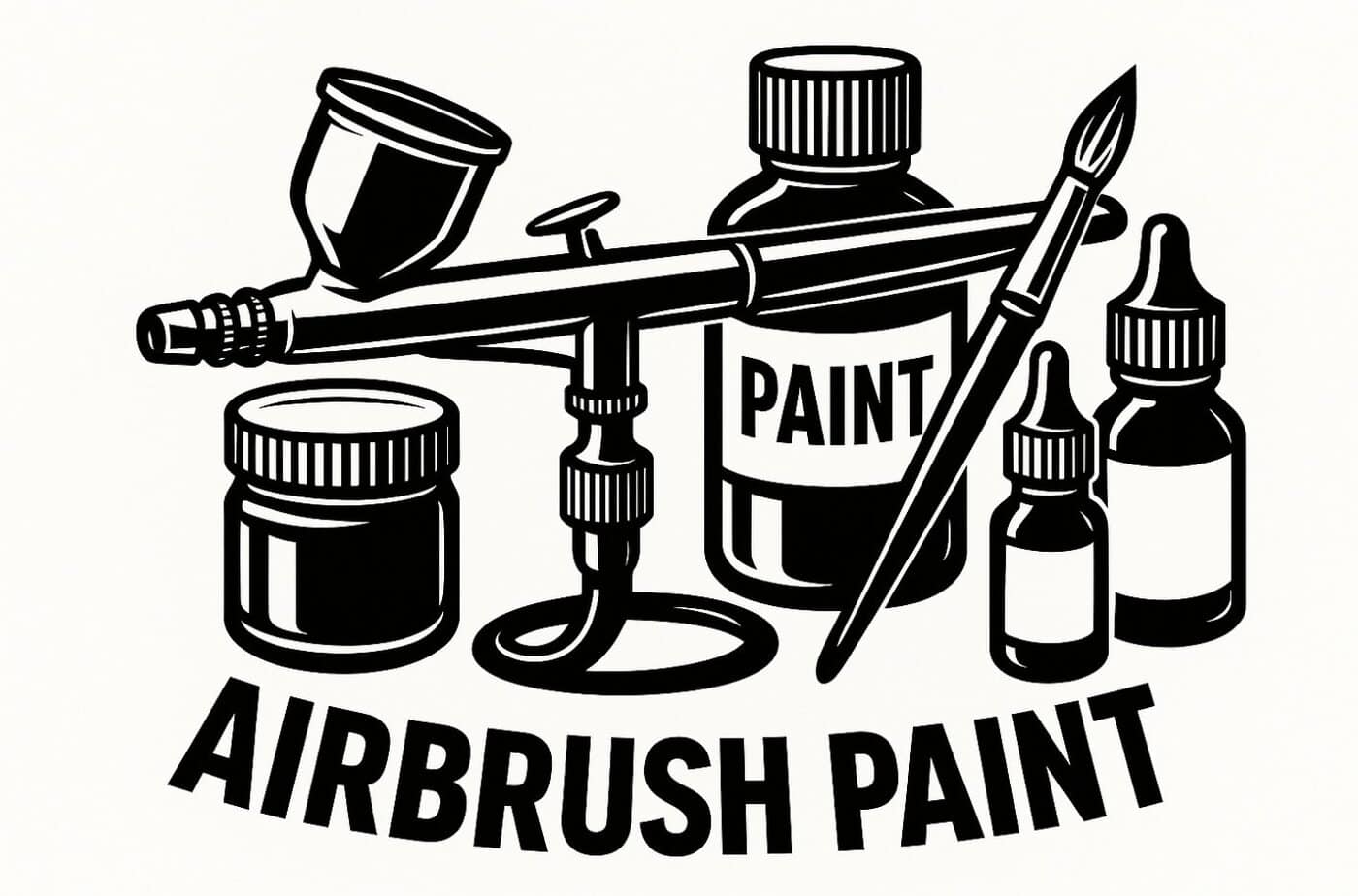Whether you’re spraying flames onto a motorcycle helmet, shading a hyperrealistic portrait, or detailing a miniature with weathered effects, the paint you feed your airbrush can make or break your project.
Airbrush paint isn’t just regular paint thinned down—it’s a purpose-built medium formulated to atomize cleanly, lay smooth, and cure with control. But with so many types, brands, and prep methods, how do you choose the right one?
In this expert guide, you’ll learn:
- The best types of paint for different surfaces and effects
- How to mix and thin your paint for flawless performance
- Airbrush compatibility tips (nozzle size, PSI, spray pattern)
- Pro-level troubleshooting and safety advice
- Real-world application tables, brand picks, and FAQs
Let’s dive into everything you need to know to pick the perfect airbrush paint—no clogging, cracking, or guesswork.
What Is Airbrush Paint?
Airbrush paint is a specially formulated liquid medium designed to spray through an airbrush’s narrow nozzle as a fine mist. It’s thinner than traditional brush paint, with finely ground pigments and additives that ensure smooth flow, adhesion, and drying.
Key Characteristics:
- Low viscosity (for atomization)
- Stable pigmentation (to avoid clogs)
- Controlled drying time (fast, but not too fast)
- Binder compatibility (with the surface being painted)
Types of Airbrush Paint (With Real-World Uses)
Here’s a breakdown of the most common types of airbrush paint and what they’re best used for:
| Paint Type | Base | Best For | Cleanup | Pros | Cons |
|---|---|---|---|---|---|
| Acrylic | Water | Art, models, fabrics, signs | Soap & water | Safe, indoor-friendly, versatile | Can dry quickly on needle |
| Urethane | Solvent | Cars, helmets, hard plastics | Solvent | Extremely durable, glossy | Toxic fumes, costly setup |
| Enamel | Solvent | Model kits, metal, RC bodies | Mineral spirits | High gloss, long blend time | Long cure, yellows over time |
| Lacquer | Solvent | Models, toys, RC planes | Lacquer thinner | Fast drying, hard shell | Fragile without clear coat |
| Textile/Fabric | Water | T-shirts, canvas, leather | Soap & water | Flexible, heat-settable | May crack if applied too thick |
| Body/Cosmetic | Water/Alcohol | Skin, prosthetics, cosplay | Soap or alcohol | Hypoallergenic options | Limited wear time |
| Edible Paint | Water/Glycerin | Cake decorating, food art | Water | Food-safe, vivid | Limited surfaces, short wear |
🎨 Pro Tip: Always match your paint to the surface and project longevity requirements. Flexibility matters on fabrics; durability matters on metal.
Paint vs. Airbrush: Are They Compatible?
Not all airbrushes can handle all paints. Nozzle size, air pressure, and feed type matter.
| Paint Type | Recommended Airbrush Type | Ideal Nozzle Size |
|---|---|---|
| Thin Acrylics | Gravity feed dual-action | 0.2–0.35 mm |
| Urethane Paints | Siphon feed or HVLP spray gun | 0.5 mm+ |
| Textile Paints | Siphon or gravity feed | 0.5–0.7 mm |
| Enamels/Lacquers | Gravity feed | 0.3–0.5 mm |
| Cosmetic/Body | Low PSI gravity feed | 0.3 mm |
| Edible Paint | Food-grade gravity feed | 0.3–0.5 mm |
💡 Smaller nozzle = more detail, but more clogs. Use thin paint for fine work and high-viscosity paint with larger nozzles.
How to Thin Airbrush Paint (Properly)
Even “ready-to-use” paint often needs thinning for detail work.
Thinning Ratios by Paint Type:
| Paint Type | Thinner | Starting Ratio (Paint:Thinner) |
|---|---|---|
| Acrylic | Water or acrylic reducer (e.g. 4012) | 3:1 or 2:1 |
| Urethane | Urethane reducer + hardener | 4:1:1 (Paint:Reducer:Hardener) |
| Enamel | Enamel thinner or mineral spirits | 2:1 or 1:1 |
| Lacquer | Lacquer thinner | 2:1 |
Always strain your thinned paint through a 125-micron filter before loading the airbrush.
Mixing Custom Paints Like a Pro
Mixing paint isn’t just about color—it’s about chemistry. Follow these best practices:
- Use a scale for accurate ratios (especially with urethanes)
- Label your mixes (color, date, ratio) for reuse
- Add flow enhancer for smoother lines and less tip dry
- Use magnetic stirrers for metallics or pearl finishes
- Mix small batches to avoid waste or separation
Safety First: Airbrushing with Health in Mind
✔️ Acrylic Paints
- Low toxicity, but atomized pigment still needs good ventilation
- Wear a dust mask or spray booth filter
⚠️ Solvent-Based Paints (Urethanes, Enamels, Lacquers)
- Emit VOCs and isocyanates—some carcinogenic
- Require full respirators, gloves, and spray booths
Skin-Safe Paints
- Use only FDA-approved, cosmetic-grade paints for body art
- Avoid regular paints on skin or food
Paint Storage & Shelf Life
Proper storage prevents clumping, separation, and spoilage:
- Store in airtight containers (preferably dropper bottles)
- Keep away from sunlight and heat
- Shake or stir before every use
- Mark custom mixes with expiration dates
⚠️ If your paint smells sour, separates irreversibly, or curdles when thinned—toss it.
Troubleshooting Common Airbrush Paint Problems
| Problem | Cause | Solution |
|---|---|---|
| Sputtering | Thick paint, low PSI, or partial clog | Thin paint, increase PSI, clean nozzle |
| Tip Dry | Fast evaporation, no flow aid | Add retarder, clean tip regularly |
| Overspray or “spidering” | Too close or too much paint | Lower PSI, increase distance, move faster |
| Paint Won’t Stick | Oily or glossy surface | Degrease, prime, or lightly scuff |
| Uneven Flow or Grainy Texture | Poor mix or low-quality paint | Use proper thinner, stir and strain paint |
Best Airbrush Paint Brands by Category
| Application | Recommended Brands |
|---|---|
| Automotive/Urethane | House of Kolor, PPG, Auto Air Colors |
| Illustration/Acrylic | Com-Art, Createx Illustration, Golden High Flow |
| Models/Scale Detailing | Vallejo Model Air, Tamiya, AK Interactive |
| Fabric/Textile | Createx Textile, Jacquard Neopaque, Angelus |
| Leather/Shoes | Angelus Leather Paint, Createx Wicked |
| Body Painting | ProAiir, EBA Performance, Mehron |
| Cake Decorating | AmeriColor, Chefmaster, Magic Colours |
Application Matching: What Paint to Use for What Project
| Project | Paint Type | Reason |
|---|---|---|
| T-Shirts & Apparel | Fabric acrylic | Stays flexible after heat-setting |
| Automotive Graphics | Urethane + clear coat | Ultra-durable, high-gloss finish |
| Miniature Models | Acrylic or lacquer | Fine pigment, quick drying |
| Portrait Illustration | Acrylic (Com-Art) | Smooth atomization, subtle blends |
| Shoes/Leather | Angelus Leather Paint | Bonds well, flexes without cracking |
| Face/Body Art | Water/alcohol-based | Hypoallergenic, sweat-resistant |
| Edible Art | Edible food paint | Food-safe, easy cleanup |
FAQs: Quick Answers to Common Questions
Can I use craft acrylic paint in an airbrush?
Yes, if you thin it properly—but clogging and uneven spray are common. Use airbrush-grade paint for best results.
Do I need to seal airbrush paint?
Yes. Use a clear coat or varnish on any project exposed to handling, moisture, or UV light.
What PSI should I use for airbrushing paint?
- Detail work: 15–20 PSI
- Textiles or base coating: 25–35 PSI
- Thicker paints or large surfaces: 35+ PSI
Can I mix different brands or types of paint?
Mixing different brands is risky—especially across bases (water vs. solvent). Stick to one line or test in small batches.
Conclusion: Pick the Right Paint, Unlock Pro-Level Results
Understanding airbrush paint is one of the most overlooked but vital parts of leveling up your airbrushing. From selecting the right type for your surface to mixing it like a pro, the knowledge you gain here helps you:
- Achieve smoother blends and sharper lines
- Eliminate clogs and surface failures
- Work more safely and efficiently
- Unlock creativity across new materials and mediums
Whether you’re a hobbyist or a full-time custom artist, make your airbrush paint work for you—not against you.

